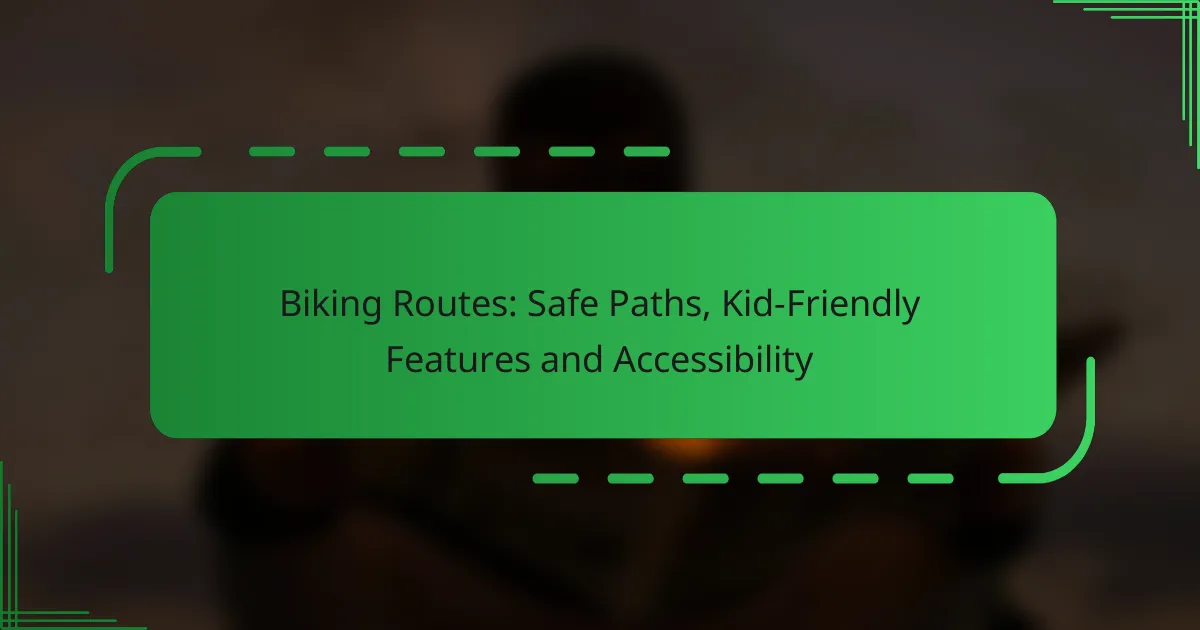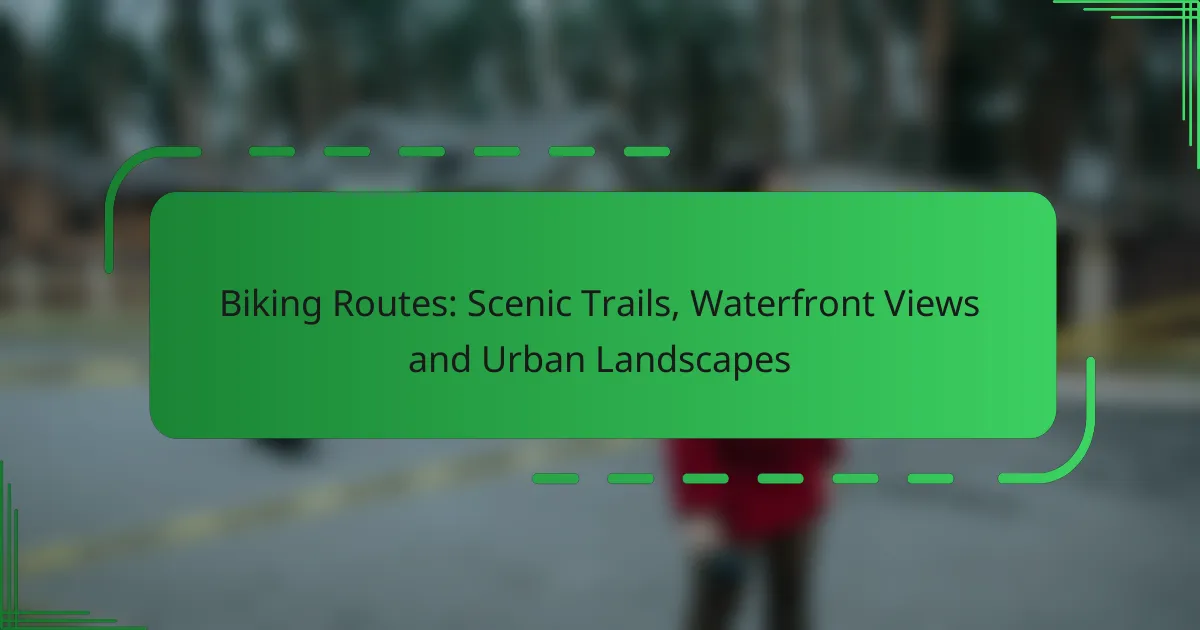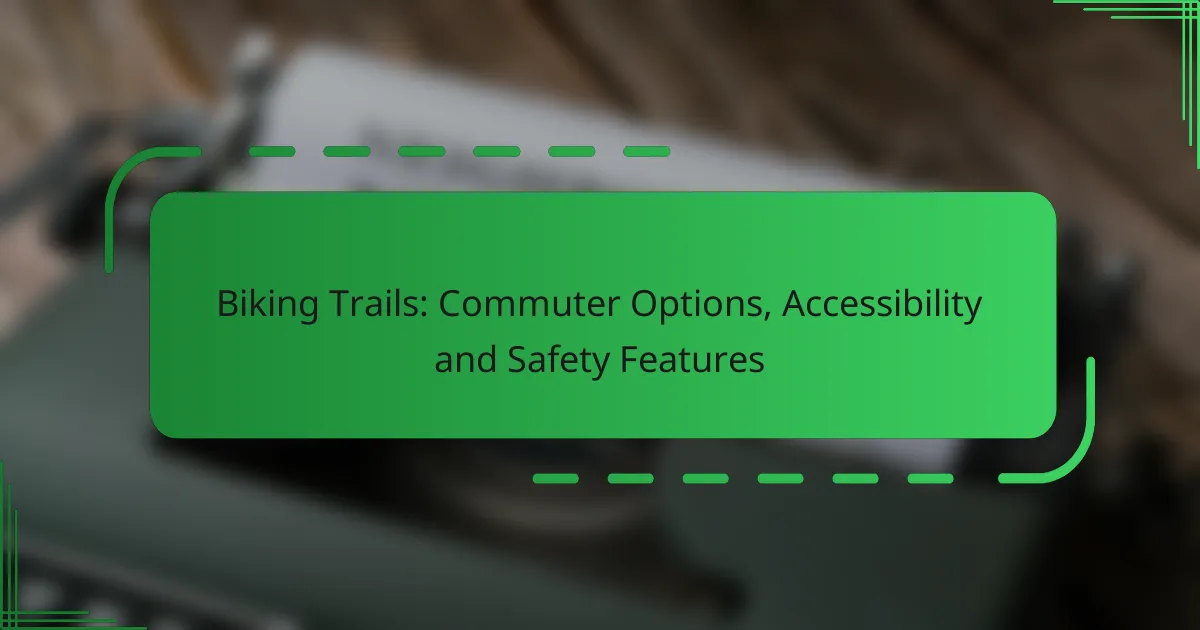Exploring the best biking routes in major US cities can lead to delightful experiences for cyclists of all ages, especially families with children. These paths, such as the Central Park Loop and Lakefront Trail, are designed with safety and accessibility in mind, featuring well-maintained surfaces and dedicated bike lanes. By choosing routes that prioritize kid-friendly features, families can enjoy a safe and enjoyable biking adventure together.
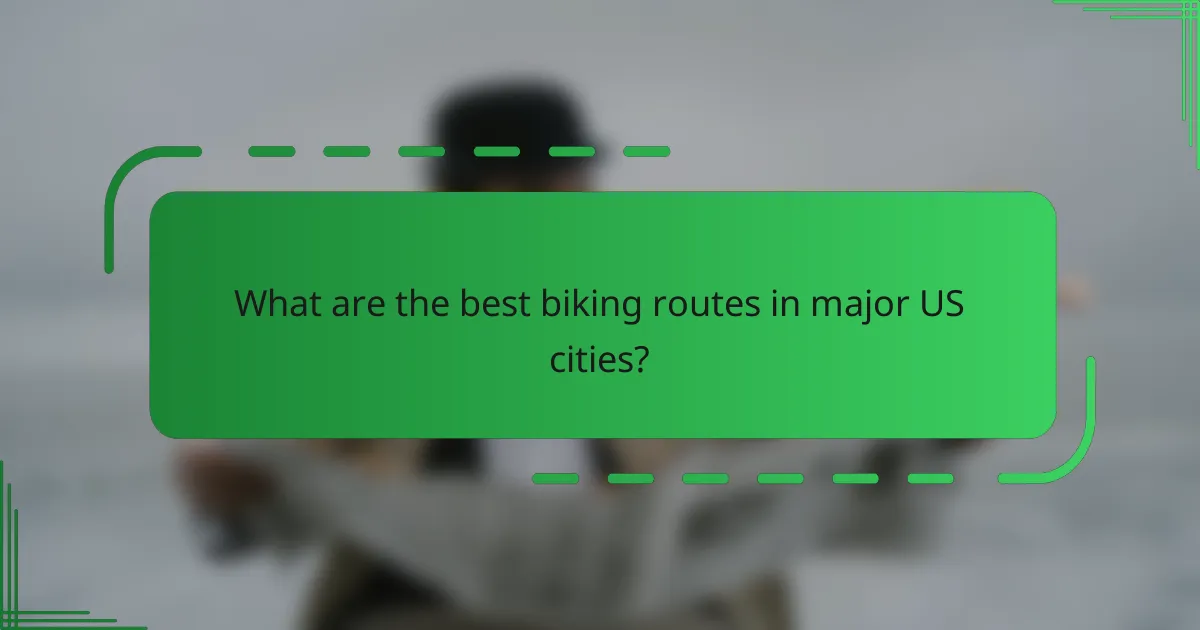
What are the best biking routes in major US cities?
The best biking routes in major US cities offer a mix of scenic views, safety features, and accessibility for all riders, including families with children. Popular routes like Central Park Loop in New York City, Lakefront Trail in Chicago, and San Francisco Bay Trail provide enjoyable experiences for cyclists of all skill levels.
Central Park Loop in New York City
The Central Park Loop is a 6-mile path that circles the park, making it ideal for leisurely rides and family outings. This route is mostly car-free, providing a safe environment for cyclists and pedestrians alike.
Key features include designated bike lanes, scenic views of the park’s landscapes, and several entry points for easy access. Riders should be mindful of pedestrians, especially during peak hours, and consider visiting early in the morning for a quieter experience.
Lakefront Trail in Chicago
Chicago’s Lakefront Trail spans approximately 18 miles along the shores of Lake Michigan, offering stunning waterfront views. This trail is popular among both recreational and commuting cyclists, featuring dedicated bike lanes that separate riders from foot traffic.
Along the route, there are numerous parks, beaches, and rest areas, making it family-friendly. Riders should be aware of potential congestion during weekends and holidays, so planning rides during off-peak times can enhance the experience.
San Francisco Bay Trail
The San Francisco Bay Trail is a network of trails that encircle the San Francisco Bay, covering over 500 miles. It provides diverse landscapes, from urban areas to natural habitats, making it suitable for all types of cyclists.
This trail is well-marked and includes sections that are accessible for families and those with mobility challenges. Riders should check local guidelines, as some areas may have specific rules regarding bike usage and safety gear. Regular maintenance ensures the trail remains in good condition, but cyclists should always be prepared for varying terrain.

How to find safe biking paths for families?
Finding safe biking paths for families involves researching designated routes that prioritize safety and accessibility. Look for paths that are well-maintained, have minimal traffic, and include features suitable for children.
Use the Safe Routes to School program
The Safe Routes to School program aims to make biking and walking to school safer for children. This initiative often includes the development of dedicated bike lanes, improved crosswalks, and educational resources for families.
To utilize this program, check with your local school district or community planning office for available resources and initiatives. Many areas offer maps that highlight safe routes specifically designed for children commuting to school.
Check local biking maps and apps
Local biking maps and apps can provide valuable information on safe biking paths in your area. These resources often highlight bike lanes, trails, and routes that are family-friendly and well-maintained.
Popular apps like Strava, Komoot, or local government resources can help you find the best routes. Look for features such as user reviews, route difficulty levels, and safety ratings to ensure the paths are suitable for kids.

What features make biking routes kid-friendly?
Kid-friendly biking routes prioritize safety, enjoyment, and accessibility for younger riders. Features such as dedicated bike lanes and play areas along the route enhance the overall experience for families, ensuring that children can ride safely and have fun.
Dedicated bike lanes
Dedicated bike lanes are crucial for creating safe biking environments for children. These lanes are typically separated from vehicle traffic, reducing the risk of accidents and allowing kids to ride with more confidence. When selecting routes, look for paths that have clearly marked bike lanes, ideally with physical barriers separating them from cars.
In urban areas, many cities have implemented dedicated bike lanes that are at least 1.5 meters wide. These lanes should be well-maintained and free from debris to ensure a smooth ride. Parents should consider routes with lower traffic volumes and speed limits to further enhance safety.
Play areas along the route
Incorporating play areas along biking routes adds an element of fun and breaks up longer rides for kids. These areas can include parks, playgrounds, or open spaces where children can stop, play, and rest. Look for routes that feature these amenities within a short distance, ideally no more than a few kilometers apart.
When planning a biking trip, check local maps or apps that highlight parks and recreational areas. This can help you create a route that balances biking with opportunities for play, making the experience enjoyable for the whole family. Always ensure that the play areas are safe and well-equipped for children of various ages.
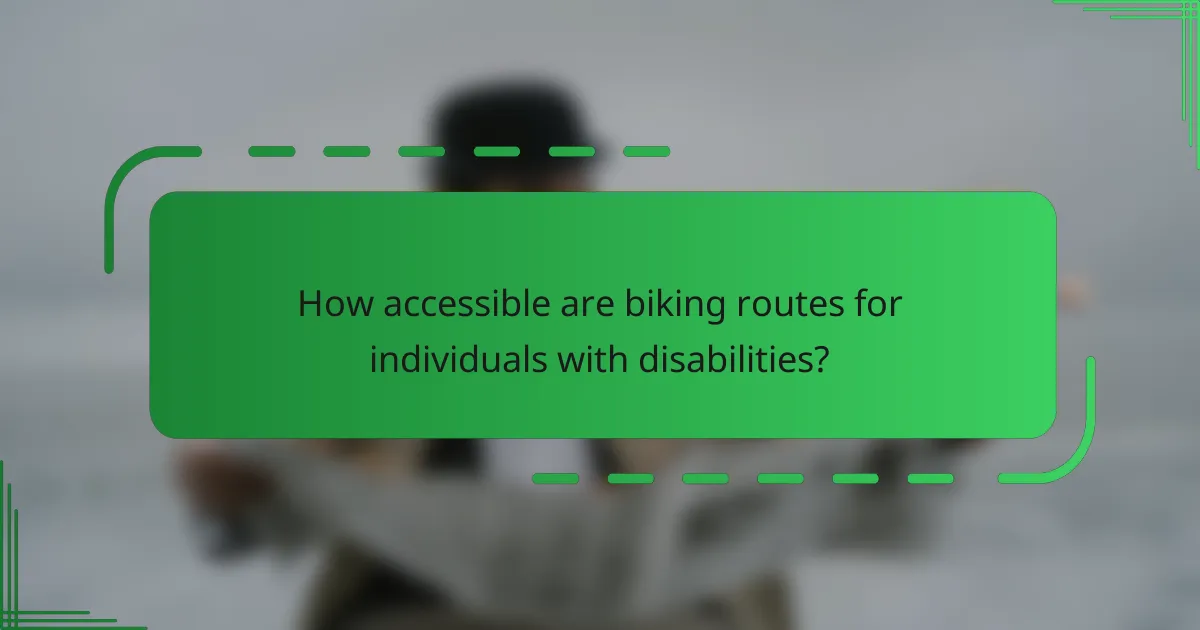
How accessible are biking routes for individuals with disabilities?
Biking routes can vary significantly in accessibility for individuals with disabilities, depending on the region and the specific trail features. Many areas are improving their infrastructure to ensure that biking paths accommodate adaptive bikes and provide safe, navigable surfaces.
Adaptive bike rentals available
Many cities and recreational areas now offer adaptive bike rentals designed for individuals with disabilities. These bikes come in various styles, including hand cycles and tandem bikes, allowing for a range of mobility options. Rental facilities typically provide training and assistance to ensure a safe riding experience.
When looking for adaptive bike rentals, check local bike shops or community centers that specialize in inclusive recreation. Some organizations may offer subsidized rates or free rentals for individuals with disabilities, making it more accessible.
Accessible trail surfaces and signage
Accessible biking routes often feature smooth, stable surfaces such as asphalt or compacted gravel, which are easier for adaptive bikes to navigate. Additionally, trails should be free of obstacles like large rocks or deep ruts that could pose hazards. Look for trails that meet accessibility standards, which may include a slope of no more than 5% in certain areas.
Clear signage is crucial for ensuring that individuals with disabilities can navigate biking routes safely. Signs should include information about trail conditions, accessibility features, and emergency contact points. Many parks are now implementing universal symbols to enhance understanding for all users.

What criteria should you consider when choosing a biking route?
When selecting a biking route, consider factors such as traffic levels, safety, scenic views, and available amenities. These criteria help ensure a pleasant and secure biking experience, especially for families and those with accessibility needs.
Traffic levels and safety
Assessing traffic levels is crucial for safety on biking routes. Look for paths with low vehicle traffic or dedicated bike lanes, which significantly reduce the risk of accidents. Routes through residential areas or parks often have less traffic and are safer for families.
Check local regulations regarding bike paths and road-sharing rules. Some cities have specific guidelines for bike usage, which can enhance safety. Always wear a helmet and ensure that children are equipped with proper safety gear.
Scenic views and amenities
Scenic views can enhance the biking experience, making it more enjoyable for riders of all ages. Routes that pass through parks, waterfronts, or nature reserves often provide beautiful landscapes and a more relaxing atmosphere. Look for trails that offer rest stops or picnic areas along the way.
Amenities such as bike repair stations, restrooms, and water fountains can make a biking trip more comfortable. Check local biking maps or apps that highlight these features, ensuring a well-equipped journey. Prioritize routes that cater to families, as they often include kid-friendly facilities and attractions.
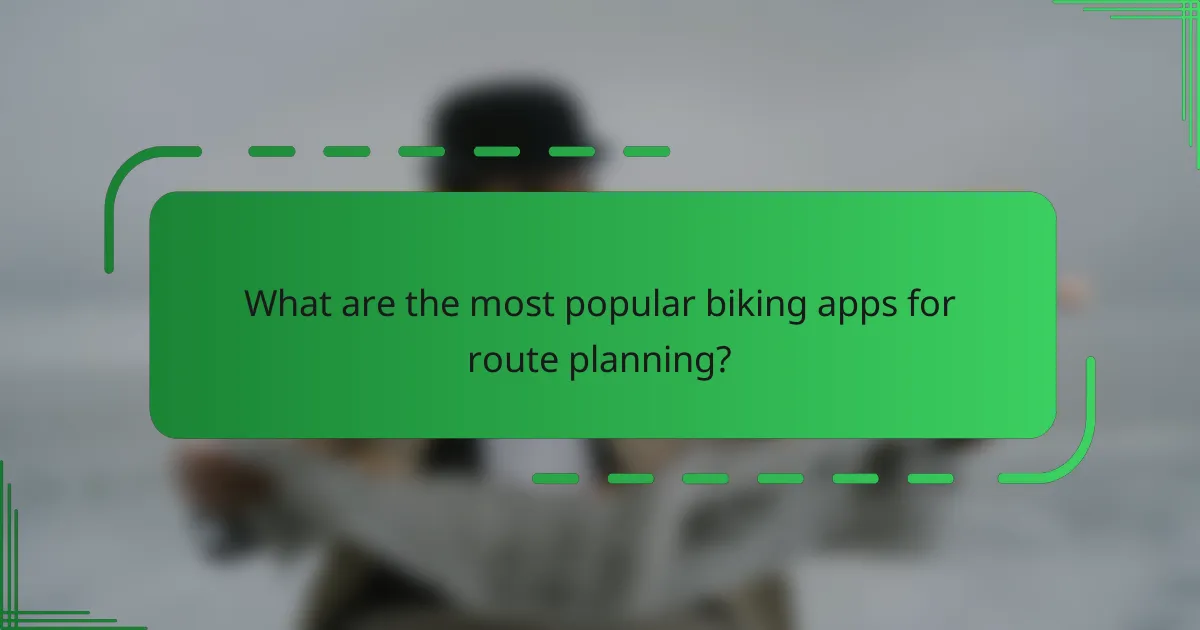
What are the most popular biking apps for route planning?
Some of the most popular biking apps for route planning include Strava and MapMyRide. These applications help cyclists find safe paths, track their rides, and connect with other biking enthusiasts.
Strava for tracking and community
Strava is well-known for its tracking capabilities and strong community features. Users can log their rides, monitor performance metrics, and share their routes with friends or the broader Strava community.
The app allows cyclists to compare their times on specific segments of a route, fostering a sense of competition and motivation. Strava also offers social features, such as following friends and joining clubs, which can enhance the biking experience.
MapMyRide for route suggestions
MapMyRide excels in providing route suggestions tailored to user preferences. Cyclists can search for routes based on distance, difficulty, and terrain type, making it easier to find suitable paths for different skill levels.
The app includes features like elevation profiles and user-generated routes, which can help in planning rides that are both enjoyable and safe. Additionally, MapMyRide offers integration with fitness trackers, allowing for comprehensive ride analysis.

How can local governments improve biking infrastructure?
Local governments can enhance biking infrastructure by investing in dedicated bike lanes and promoting public awareness about cycling safety. These improvements not only make biking safer but also encourage more residents to choose cycling as a viable transportation option.
Implement more bike lanes
Creating more bike lanes is essential for improving biking infrastructure. Dedicated lanes reduce the risk of accidents by separating cyclists from motor vehicle traffic, making it safer for families and casual riders. Local governments should consider implementing protected bike lanes where possible, as these provide an additional buffer between cyclists and cars.
When planning new bike lanes, cities should prioritize high-traffic areas and routes connecting key destinations, such as schools, parks, and commercial centers. A well-designed bike lane network can significantly increase cycling rates, contributing to healthier communities and reduced traffic congestion.
Increase public awareness campaigns
Public awareness campaigns are crucial for educating both cyclists and motorists about road safety and the rights of cyclists. Local governments can launch initiatives that promote safe biking practices, such as wearing helmets and following traffic signals. These campaigns can be conducted through social media, community events, and partnerships with local businesses.
Additionally, highlighting the benefits of cycling—such as reduced environmental impact and improved health—can encourage more people to take up biking. Engaging local schools in these campaigns can also foster a culture of cycling among younger generations, making it a more common mode of transportation.

What emerging trends are shaping biking routes in urban areas?
Emerging trends in urban biking routes focus on enhancing safety, accessibility, and user experience through innovative designs and technologies. Cities are increasingly adopting measures that prioritize cyclist needs, making biking a more viable transportation option.
Integration of smart technology
Smart technology is transforming urban biking routes by incorporating features like real-time tracking, smart traffic signals, and bike-sharing systems. These innovations help cyclists navigate more efficiently and safely through urban environments.
For instance, cities are implementing bike lanes equipped with sensors that detect cyclist presence, adjusting traffic signals accordingly to minimize wait times. Additionally, mobile apps provide users with information on bike availability, route conditions, and safety alerts.
When considering smart technology for biking routes, municipalities should focus on user-friendly interfaces and reliable data to ensure cyclists can easily access the information they need. Investing in robust infrastructure is crucial for maximizing the benefits of these technologies.
